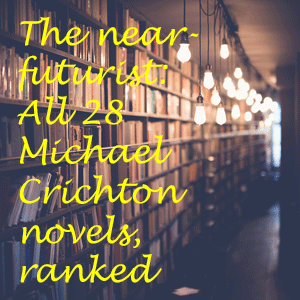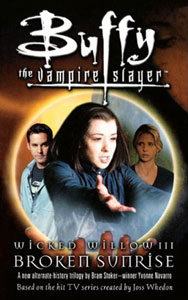I thought the alternate-reality “Wicked Willow” trilogy was starting to get good with its second book, “Shattered Twilight,” but it comes crashing down again with “Broken Sunrise” (September 2004). In my reviews, I’ve somewhat facetiously said author Yvonne Navarro is exploring what would happen if Willow was evil for a longer time period, and unfortunately, that – and Willow being even more evil, but for no apparent reason – is what it comes down to.
The most memorable part of “Broken Sunrise” finds Willow allowing two Gnarl demons (from “Same Time, Same Place,” 7.3) to paralyze and eat strips of flesh from Dawn, Xander and Giles. It’s memorable because it’s so incredibly gruesome and because I kept thinking “Willow wouldn’t do this.” There isn’t even a plot reason for her to do this, such as sacrifices being necessary for Tara’s resurrection or something like that.
Ultimately, she heals her three former friends because the Ghost of Tara asks her to, so we don’t even get the cathartic moment of Willow realizing “Wait a second; this isn’t me.” The Gnarls’ torture of our heroes with Willow standing by makes for simultaneously gripping and unpleasant reading, as Willow is the very definition of “out of character.”
The inevitable climax finds Willow unable to resurrect Tara – something the Ghost of Tara says is impossible a dozen times during the trilogy – although Yama, the god summoned by Willow, is a good character. I like how Yama chastises the arrogant Willow and contrasts her with a woman from the past who resurrected her loved one for selfless reasons.
A lot of the plot points are resolved through magick, which is understandable given the subject matter, but the problem is magick is too often used for narrative convenience. For example, the two members of the coven who got magicked to parts unknown reappear (Giles performs a spell at the Magic Box) just as the girls’ families are arguing with Willow outside her headquarters. The girls don’t know where they’ve been, but are normal and healthy. Also conveniently, two other coven members who are killed in service to Willow don’t have any family members protesting.
I was happy that Navarro adds Amy to Willow’s coven in the second book, but Sunnydale’s second-most-powerful witch has absolutely nothing to do in “Broken Sunrise.” A sociopath who loves magick, Amy is apparently a difficult character to write, and I suspect Elizabeth Anne Allen’s performance is a big reason why she’s so entertaining in the TV series. Amy rarely makes an impression in the spinoff fiction, but if the author doesn’t even try, she’s definitely not going to make an impact. I thought perhaps Amy could’ve been a driving force pushing Willow to more extreme evil acts, but what really happens is that Willow is more evil in this trilogy (compared to the TV series arc) for no good reason.
As the trilogy winds down, Navarro becomes less interested in the alternative paths she had suggested for the Scoobies. Things pick up when Oz returns to human form and Spike regains his sanity, but then those two drop out of the story again. Anya gets a good action sequence (Navarro always gives her more to do than other authors), but Xander’s too busy being tortured by a Gnarl demon to iron out his relationship with Anya. And Dawn is likewise too busy being tortured to get into it with Buffy about how her big sis won’t let her help with the Scoobying.

When Navarro does a straight adaptation of the end of “Grave” (6.22) to wrap up the trilogy, we’re reminded that the Buffy-Dawn conflict was a big part of Season 6, whereas it isn’t in these books. The author’s prose is too enjoyable on a surface level for me to give “Broken Sunrise” too low of a grade, but ultimately, the “Wicked Willow” trilogy doesn’t justify its existence. We see what would happen if Willow was more evil than she really is – by the nature of the character established by the TV writers and Alyson Hannigan’s performance. But that’s not enough of a premise to hang a “What if?” story on, especially with all the other characters’ alternative paths petering out.
Click here for an index of all of John’s “Buffy” and “Angel” reviews.

